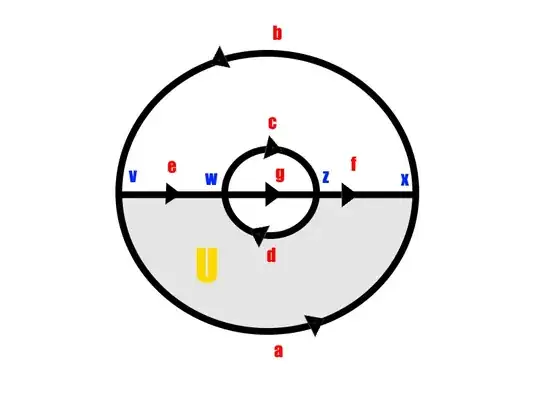I tried to discover the singular homology groups of a simplex, but I found some dificulties and want to know if someone knows what I've got wrong. The simplex is the following (0-cells are in blue, 1-cells in red and 2-cells in yellow):
As it looks like a Pokeball, I called this space $PB$. First, I drew the following chain complex:
$0\overset{\partial_3}{\rightarrow}\mathbb{Z}\overset{\partial_2}{\rightarrow}\mathbb{Z}^7\overset{\partial_1}{\rightarrow}\mathbb{Z}^4\overset{\partial_0}{\rightarrow}0$
as there are one 2-cell, seven 1-cells and four 0-cells. After it, I concluded the following about the boundary operator $\partial_1$:
$\partial_1 (a)=x-v=\partial^{-1}_1(b)$
$\partial_1(d)=w-z=\partial^{-1}_1(c)=\partial^{-1}_1(g)$
$\partial_1(e)=w-v$
$\partial_1(f)=x-z$
As a clear consequence, $H_0(PB)=\frac{ker\partial_0}{im\partial_1}=\frac{\mathbb{Z}^4}{\mathbb{Z}^4}=0$. As well, we have
$\partial_1(ab)=0$
$\partial_1(cd)=0$
$\partial_1(dg)=0$
$\partial_1(cg^{-1})=0$
After it, I tried to analyse the boundary operator $\partial_2$. Here, however, I found some dificulties. First, how to even define $U$? Would it be equal to $[vwzx]$? I tried to calculate it as if $U=[vwzxv]$, which gave me:
$\partial_2(U)=\partial_2([vwzxv])=-d+a+f+e=e-d+f+a$
which sounded somehow correct to me. However, after it, how could I even compute the kernel of $\partial_2$? Maybe I'm wrong in some definition or I'm using improper concepts. Boundary operators of 2-cells became a huge problem on many of my computations. Thank you for all your answers.
